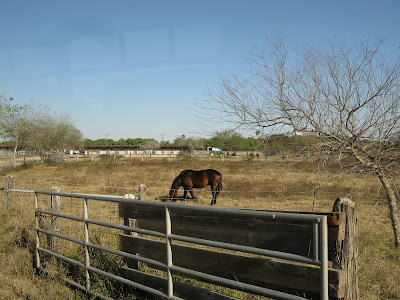About an hours drive south of us is King Ranch, one of the largest ranches in the world at 825,000 acres. It was founded by Captain Richard King in 1853 after he bought 2 Spanish land grants. Besides owning this ranch in Texas, they now own large tracts of land in Florida for growing oranges and in New Mexico for growing pecans. At one time they owned over twice as much land with holdings in Australia, Africa and South America but have sold all those off. They do tours around the ranching areas so we thought we'd give it a go.
He was a river boat captain along the Rio Grande and decided to go into ranching so he rode for days through the desert and decided to start his ranch when he found this river, the first fresh water since he left the Rio Grande. This bridge was built later for the stagecoach route from Brownsville to Matamoros Mexico.
After the ranch was well established, they built this home. It is 36,000 square feet with 17 bedrooms and 19 bathrooms. Because there wasn't any town nearby, travelers as well as guests could stay here for a night or two. Not much of a picture, but the house is surrounded by trees and you can't get much of a picture.
This is the front entrance, see what I mean. The house is still fully staffed and there are usually some of the 150 family members staying for a few days at any given time. We didn't get an invite in, unfortunately.
When he first started ranching the common cattle was the Texas longhorn. They are quite impressive with over 6 foot horns. They were very rugged and could survive on nothing but they didn't have much meat and didn't sell for much so Captain King started breeding different cattle.
He bred these British shorthorns with Brahma bulls from India and spent years getting the breed ratio right. He ended up with a massive animal that was rugged and put weight on fast. They were registered as Santa Gertrudis, the first new breed of cattle registered in over 100 years. The original sire reached over 2800 pounds. Packing plants started complaining that the animals were getting too large for them to slaughter and handle so King Ranch started a new breeding program and a few years ago came out with another new breed called the Santa Cruz cattle.
The Santa Cruz is a smaller animal but also has smaller bones and actually has more meat after butchering than the much larger Santa Gertrudis. It matures and has calves in about 18 months, over 6 months sooner than the S.G. which means the herd grows much quicker. These calves are only 6 months old and are about the size of a dairy cow already. The ranch has over 50,000 cattle and constantly ship hundreds a day to market.
The ranch is divided into hundreds of fields and pastures so they developed an automatic cattle gate so time wouldn't be wasted opening and closing gates. The vehicle bumps the swinging gate and drives through before it swings closed. As the gate opens, the chain twists around the centre pole and untwists to close the gate. There is a knack to it though; hit it too hard and it slaps you on the ass, too light and it scrapes the side.
When Captain King needed horses to work the ranch, he went down to Mexico and bought hundreds of horses. At one town where he stopped he realized that it was very poor and if he bought all their horses they would be destitute. He invited the whole town to move to his ranch where he would give them work, shelter, food and medical. The whole town packed up everything they owned and moved to his ranch. He now had hundreds of cowboys and horses to work his ranch. The descendants of the original Mexicans still work on the ranch. This retired Mexican cowboy told of his life on the ranch. He is a great great grandson of one of the original Mexicans and his boys are now working there. They get free housing, free schooling, free medical and a job for life. Not a bad arrangement.
The size of the ranch and the amount of cattle worked meant that the existing type of horse wasn't adequate for the job so King Ranch started a breeding program to improve the quality of the horses. They were looking for horses that were quick, had cattle sense and stamina. After many years of cross breeding a horse was developed that had these traits. This was the start of the Quarter Horse and the original sire had the designation of "1" on the quarter horse registry. All quarter horses have come from this breeding program.
After the tour, we sat in the visitors area and ate the lunch grammie packed. Original wagons were located around the grass. The red chuckwagon shows the King Ranch brand which was called the running W. Apparently its one of the most difficult brands for a rustler to over brand and claim for his own. In the back of the open wagon is a big ball of barbed wire from the 1860's. They don't use any barbed wire on the ranch due to cuts which get infected easily in the hot climate. They have enough miles of fencing to stretch halfway across America.
After lunch we went to see the King Ranch saddle shop where they still make saddles for the ranch hands as well as retail many other items. Very pricey but great quality. Here's a long horn close up. I wouldn't want him trying to gore me. The ranch place is immense and a 2 hour tour only covered one corner of the cattle operation. They also have the largest cotton fields in America here in their Texas holdings. An interesting day for sure.












No comments:
Post a Comment